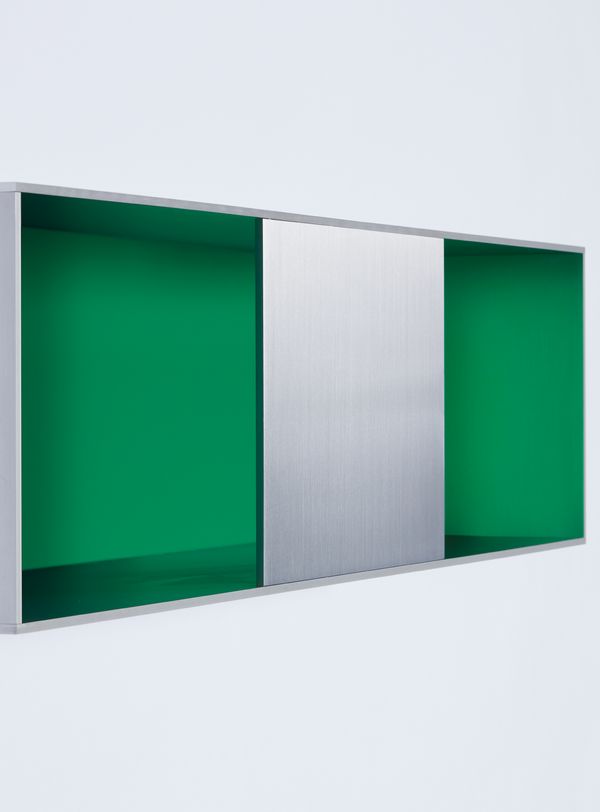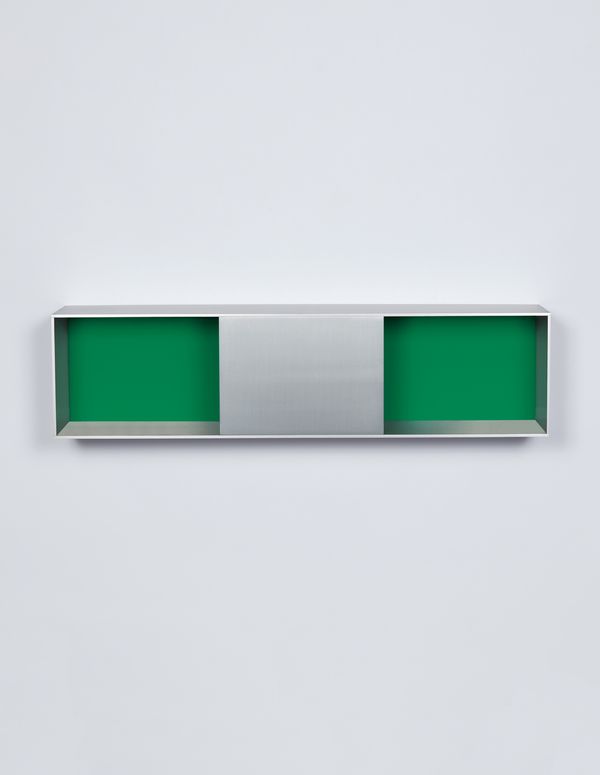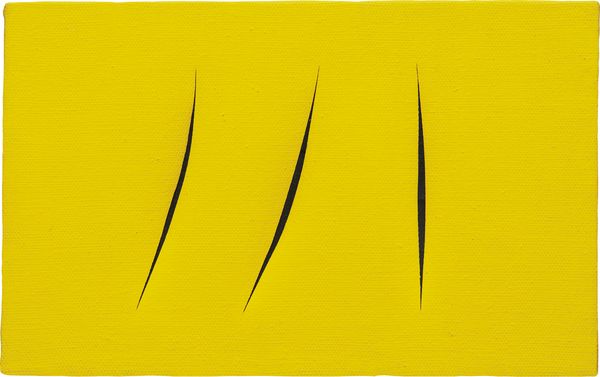Richard Prince Untitled (Cowboy), executed in 1989. This work is artist's proof number 1 from an edition of 2 plus 1 artist's proof.
[Prince's cowboys]...represent one of his early experimentations with appropriated imagery
Richard Prince's cowboys are among the most iconic examples of his prolific oeuvre.
The above lot, an early work from 1989, is a unique artist's proof aside from the artist's small editioned series of luminously colored photographs, representing one of his early experimentations with appropriated imagery. Adapted from a Marlboro cigarette advertisement, this work depicts three quintessentially American cowboys in a receding row, looking off into the distance. They are dressed in patriotic garb, adorned in red, white and blue, set against what is assumed to be a warm, sunny Western landscape. All three men are smiling in symmetrical, profile view, not one making direct eye contact with the camera.
While the photograph is anything but candid, Prince's choice of cropping at the brims of their hats and extending only to their upper torsos captures a split second in time that gives the essence of a genuine, American moment.
As Prince has described, the cowboy pictures "were too good to be true. They were about wishful thinking, public pictures that happen to appear in the advertising sections of mass-market magazines...it was their look I was interested in. I wanted to represent the closest thing to real thing." To achieve this level of reality, Prince has removed the text from the Marlboro advertisement, reframing the image in a way that rejects the obvious reappropriation of mass media sources, and instead elevates the source imagery to one that is seemingly original. The result is paradoxically comforting and disquieting, calling into question the meaning behind the staged smiles. It is "normalcy as special effect," as Prince once explained, thus challenging the notions of Pop art begun by his predecessors, and elevating the nostalgic to the extraordinary. (Rosetta Brooks, "A Prince of Light or Darkness?", Richard Prince, London, 2003, p. 56)
[Untitled demonstrates Judd's] rejection of the traditional artist's studio in favor of the factory as a place of artistic production.
Donald Judd Untitled, 1991.
Executed in 1991, only three years before the artist's passing, Untitled exemplifies Donald Judd's commitment to material, space and color as the three fundamental elements of art. A key figure of the Minimalist movement beginning in the 1960s, Judd continually rejected traditional notions of art history, as demonstrated by the above lot.
From 1988 to 1994, Judd worked with Alu Menziken, an aluminum manufacturing company based in Switzerland, in the construction of these industrial boxes. Menziken's primary area of focus was the production of automobiles, machinery and aerospace, making Judd's preference for working with this company a true testament to his aesthetic ideology and practice—a rejection of the traditional artist's studio in favor of the factory as a place of artistic production.
In Untitled, Judd utilizes the industrial materials of clear anodized aluminum and colored acrylic sheets to create a singular form that is without allusion to the pictorial world. The floating rectangular box, a defining characteristic of the works fabricated by Menziken, is bisected by a central panel, which divides the sculpture into three equal parts. While the viewer is initially confronted with a powerful, static form, new spatial relations come into play as his or her position shifts, reflecting the surrounding space in different iterations.
In its design, Judd experiments with the striking dichotomy inherent within the structure of the Menziken-fabricated works, and also alludes to the importance of color. While the outer aluminum structure remains austere and unchanging, the interior is imbued with a richness and complexity made possible by the emerald green hue of the acrylic sheet. Floating and isolated, each of these boxes takes on a wholly distinct personality with each color variant. Ultimately, and as exemplified by the above lot from our 20th Century & Contemporary Art Day Sale, Judd's preference for modest, simple forms allowed him to truly explore the artistic possibilities of color, light and space for which he is renowned.
The gestural slashes, a momentous, seemingly violent act, disrupts the purity of the monochromatic surface.
Lucio Fontana Concetto spaziale, Attese, 1962
"I do not want to make a painting; I want to open up space, create a new dimension for art, tie in with the cosmos, as it endlessly expands beyond the confining plane of the picture. With my innovation of the hole pierced through the canvas in repetitive formations, I have not attempted to decorate a surface, but on the contrary, I have tried to break its dimensional limitations" —Lucio Fontana, as quoted in Lucio Fontana, exh. cat., Walker Art Center, Minneapolis, 1966.
Striking in both color and form, Concetto spaziale, Attese reflects Lucio Fontana's fascination with space travel and his radical post-modernist vision of art. In the 1946 Manifesto Blanco (White Manifesto), overseen by Fontana, he laid the groundwork for the technical and spatial experiments that occupied him for the rest of his life. Fontana sought to develop a new artistic language that could convey an infinite dimension, breaking from the traditional view of art by combining sculpture, painting and architecture. Begun in 1958, Fontana's tagli, like the present example, display his mastery of these complex theories and his evolved technical perfection:
Fontana incised the painted canvas and then gently opened the cut with his hands, exposing a dimensional space that exists below the flat surface, thus transforming the work into a sculptural object. The gestural slashes, a momentous, seemingly violent act, disrupts the purity of the monochromatic surface. Beyond the physical implications of the work, the inclusion of "attese" in the title, which translates to "expectations," suggests a contemplative interpretation of the object as existing both in space and in time, furthering Fontana's desire to represent the infinite.
In 1966, Fontana exhibited his Concetto Spaziale series in the Italian Pavillion at the XXXIII Venice Biennale and won the International Grand Price for Painting, just two years before his death. There, white canvases with these iconic cuts were hung in a white room designed by architect Carlo Scarpa, creating an immersive "spatial environment."
Executed in 1962, Concetto spaziale, Attese is a prime example of Lucio Fontana's tagli paintings, rendered in color rather than white, arguably his most iconic and revered group of work. With its radiant yellow hue, the above lot stands out with its black depths, which stand in stark contrast to the colored ground, challenging the viewer to see through the canvas into the infinity of space.



